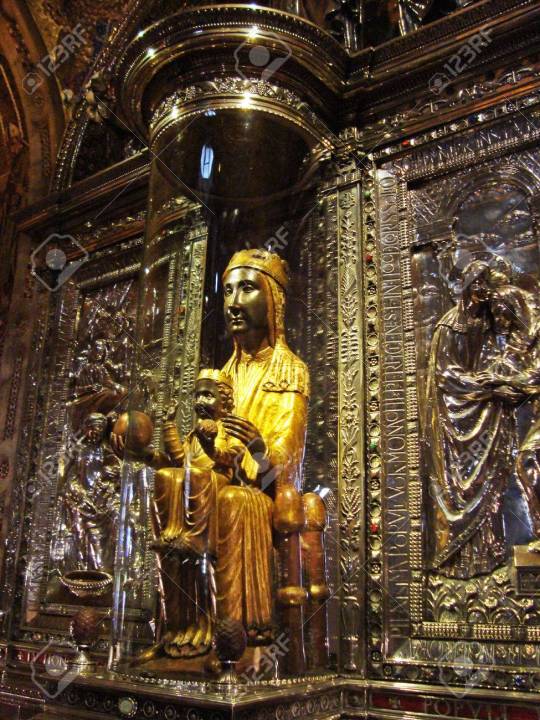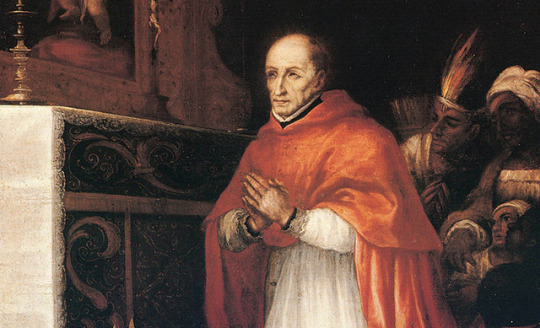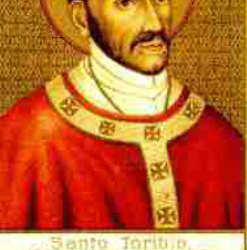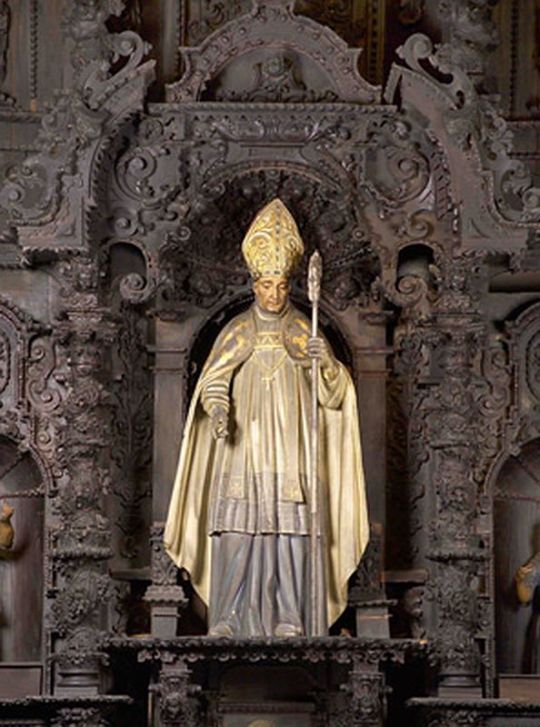#stturibiusofmogrovejo
Text
La Moreneta / Our Lady of Montserrat, Spain (718) St Peter Canisius, St Turibius of Mogrovejo and Memorials of these and more, most interesting Saints - 27 April
St Peter Canisius SJ (1521-1597) – The Known as “The Hammer of Protestantism,” “Second Apostle of Germany” – Confessor, Doctor of the Church, Dutch Priest of the Society of Jesus, Reformer, Teacher, Writer, Apostle of Charity. Patronages – Catholic Press, Germany, Catechists. The restoration of the Catholic Church in Germany after the Protestant Reformation is largely attributed to the work there…

View On WordPress
#bljakovvaringez#blnicolasroland#blosannaofcattaro#ourladyofmontalto#saints27april#stjohnofkathara#stpeterarmengol#stpetercanisius#stturibiusofmogrovejo#stzitaoflucca
16 notes
·
View notes
Text
Memorials of the Saints - 23 March
Memorials of the Saints – 23 March
St Turibius of Mogrovejo (1538-1606) (Optional Memorial)
Biography:
https://anastpaul.wordpress.com/2018/03/23/saint-of-the-day-23-march-st-turibius-of-mogrovejo-1538-1606/
Bl Álvaro del Portillo Díez de Sollano
Bl Annunciata Asteria Cocchetti
St Benedict of Campagna
St Crescentius of Carthage
Bl Edmund Sykes
St Ethelwald of Farne
St…
View On WordPress
2 notes
·
View notes
Photo

Saint of the Day – 23 March – St Turibius of Mogrovejo (1538-1606) ArchBishop, Lawyer, Professor, Missionary, Preacher, Reformer, Professor, – born Toribio Alfonso de Mogrovejo in 1538 at Mayorga de Campos, Leon, Spain and died on 23 May 1606 at Santa, Peru of natural causes. Patronages – Peru, Lima, Latin American bishops, Native rights, Scouts, Valladolid. St Turibius predicted the exact date and hour he would die, which would come to pass. His reputation for holiness and learning was never forgotten for it led to calls for his canonisation. ,,Pope Innocent XI beatified the late archbishop but Pope Benedict XIII was the one to canonise him as a saint on 10 December 1726.
Toribio Alfonso de Mogrovejo was born on 16 November 1538 in the Valladolid province in Habsburg Spain to the nobles Luis Alfonso de Mogrovejo (1510–1568) and Ana de Roblès i Morán (1515–???); He was named in honour of Saint Toribio.
He was noted as a pious child with a strong devotion to the Blessed Virgin who fasted once a week in her honour and recited rosaries often. He received an education befitting for a noble at the time; he entered the college at Valladolid in 1550 where he studied humanities. He became a professor teaching law to students at the reputed college in Salamanca. His uncle Juan de Mogrovejo served as a professor there as well as at the San Salvador High School in Oviedo before King Juan III invited him to teach at the college in Coimbra. Toribio accompanied his uncle there and studied at the college in Coimbra before returning to Salamanca sometime later. His uncle died not long after he returned to Salamanca for his studies. His learning and virtuous reputation led to King Philip II appointing him as the Grand Inquisitor on the Inquisition Court stationed at Granada in February 1571. He remained in that position until 1576 but not without impressing the king with his work.
During this time Philip II nominated him for the vacant Lima archbishopric despite his strong protests. He used his knowledge of canon law to remind him and the pope that priests alone could be designated with ecclesial dignities but the pope overruled him. Preparations were made for him to be ordained before the formal announcement could be made. He was ordained to the priesthood in 1578 in Granada (after four consecutive weeks of receiving the minor orders) and Pope Gregory XIII named him on 16 May 1579 as the Archbishop of Lima; he received his episcopal consecration in August 1580 from the Archbishop of Seville Cristóbal Rojas Sandoval. In September 1580 he departed for Peru alongside his sister and her husband.

The new archbishop first arrived in Paita on 12 May 1581 which was 600 miles – or 970 kilometers – from Lima. He began his new mission travelling to Lima on foot while he baptised and taught the natives. He was enthroned in his new see a week later. His favourite topic was: “Time is not our own and we must give a strict account of it”. He traversed his entire archdiocese three times on foot and alone; exposed to tempests and torrents as well as the wild beasts and tropical heat. He also had to deal with fevers and often threats from hostile tribes. He countered these all the while baptising and confirming almost one half million people which included the future Saint Rose and Saint Martin de Porres and also Saint Francis Solano (who later became a close friend) and Blessed Juan Masías.
He built roads and schoolhouses as well as chapels and hospitals; he never forgot about the religious and established convents for them to live in. In 1591 founded the first seminary in the western hemisphere and mandated that learning indigenous languages was a prerequisite in their formation. He inaugurated the first part of the third Lima Cathedral on 2 February 1604. He also assembled thirteen diocesan synods and three provincial councils during his tenure. He was seen as a champion of the rights of the natives against the Spanish masters. He learnt the local dialects for better communication with the native people and his own flock and was seen as a champion for rights and liberties despite Peruvian governors voicing opposition to him since he challenged their power and control.

Mogrovejo sought the reformation of diocesan priests and found that some of their behaviour had grown too scandalous to be continued. There were those priests who came to resent him for this though Francisco de Toledo supported his reform efforts and rendered assistance to the archbishop in that regard. He also oversaw the Third Provincial Council from 1582 to 1583 which Philip II had requested he oversee. He served as the council’s president but guided it rather than lead it; he involved himself in drafting important concilliar documents. Mogrovejo also worked to implement the decrees from the Council of Trent and made evangelisation a core theme in his episcopal career. He produced a trilingual catechism in Spanish as well as in the native languages Quechua and Aymara in 1584 while the council mandated confessional manuals to aid confessors while calling for preaching in indigenous languages. The council issued a decree from the council – one he endorsed – that proscribed excommunication to those clerics who engaged in business ventures since it was known that there were some clerics who exploited the natives for work and profit.
The council ended and Pope Sixtus V confirmed its decrees in 1588. He held two more provincial councils in 1591 and in 1601. Mogrovejo made three pastoral visitations that were all extensive in time. He visited each parish and would first inspect all objects for divine worship (he expected them to be in good condition) before talking to the parish priest about the life of the parish. He would then check the parish registers and then checked to see if the priest had the missal that Pope Pius V had mandated over a decade prior.

His prediction of the exact date and hour of his death, would soon come to pass. It was in Pacasmayo during a pastoral visit that he contracted a fever but continued labouring to the last and arrived at Saña in a critical condition. He dragged himself to receive the Viaticum and died not long after this on 23 March 1606 (Holy Thursday) at 3:30pm at the Saint Augustine convent. His final words were those of Jesus Christ on the Cross: “Lord, into Thy hands I commend my spirit”. His remains are interred in the archdiocesan cathedral.

His beatification was celebrated under Pope Innocent XI in 1679 (ratified in the papal bull “Laudeamus”) and Pope Benedict XIII later canonised him as a saint on 10 December 1726 through the papal bull “Quoniam Spiritus”. His liturgical feast was once celebrated on 27 April but is now celebrated on 23 March. His cult was once confined for the most part to South America but is now universal because of his pioneering reforms. He became the patron saint for the Latin American episcopate after Pope John Paul II proclaimed him as such in 1983.
Cardinal Juan Luis Cipriani Thorne spoke on Mogrovejo as a tireless pastor who never tired “being close to God” whose “love for the poor manifested itself in the innumerable gestures” that marked his episcopal life. Thorne further elaborated that “in Saint Toribio we reinforce our conviction that the time devoted to God is a guarantee of a faithful dedication to the fulfilment of our duties and to the service of our brothers”.
(via AnaStpaul – Breathing Catholic)
26 notes
·
View notes
Photo

One Minute Reflection – 23 March – Friday of the 5th Week of Lent 2018 and the Memorial of St Turibius of Mogrovejo (1538-1606) – Today’s Gospel John 10:31-42
The Jews took up stones again to stone him...John 10:31
REFLECTION – “If all goes well with you on earth, how can you expect to be crowned in heaven for a patience you never practised? How can you be Christ’s friend if you will not be opposed? Therefore, you must suffer with Christ and for Christ, if you want to reign with Him.”…Thomas à Kempis (1380-1471) The Imitation of Christ, Book 2

PRAYER – Lord, through the pastoral care, suffering and zeal of St Turibius, You built up Your Church in Peru. Grant that the people of God may continually grow in faith and holiness. Accept his prayers on our behalf, that we may always be willing to stand at Your Cross. Through our Lord, Jesus Christ, in the unity of the Holy Spirit, one God forever amen.
(via AnaStpaul – Breathing Catholic)
#mypics#mypic#oneminutereflectionmarch23#stturibiusofmogrovejo#john10:31#fridayofthe5thweekoflent2018#thomasakempis#catholic#catholicism
4 notes
·
View notes
Photo

Thought for the Day – 23 March – The Memorial of St Turibius of Mogrovejo (1538-1606)
Nothing gave our saint so much pleasure as the greatest labours and dangers, to procure the least spiritual advantage to one soul. Burning with the most vehement desire of laying down his life for his flock and of suffering all things for Him who died for us, he feared no dangers. When he heard that poor Indians wandered in the mountains and deserts, he sought them out; and to comfort, instruct, or gain one of them he often suffered incredible fatigues and dangers in the wildernesses and boldly travelled through the haunts of wild animals.
The ardour of his faith, his hope, his love of his Creator and Redeemer, his resignation and perfect sacrifice of himself, gathered strength in the fervent exercises and aspirations which he repeated almost without ceasing in his illness. By his last will he ordered what he had about him to be distributed among his servants and whatever else he otherwise possessed to be given to the poor.
His body when translated the year after his death to Lima, was found incorrupt, the joints flexible, and the skin soft.
The Lord indeed writes straight with crooked lines. Against his will and from the unlikely springboard of an Inquisition tribunal, this man became the Christlike shepherd of a poor and oppressed people. God gave him the gift of loving others as they needed it. St Turibius, pray for us!

“Remember that you will derive strength
by reflecting that the saints
yearn for you
to join their ranks;
desire to see you fight bravely,
and behave like a true knight
in your encounters
with the same adversities
which they had to conquer,
and that breathtaking joy
is their eternal reward
for having endured a few years
of temporal pain.
Every drop of earthly bitterness
will be changed into
an ocean of heavenly sweetness.”
Blessed Henry Suso O.P. (1290-1365)
(via AnaStpaul – Breathing Catholic)
14 notes
·
View notes